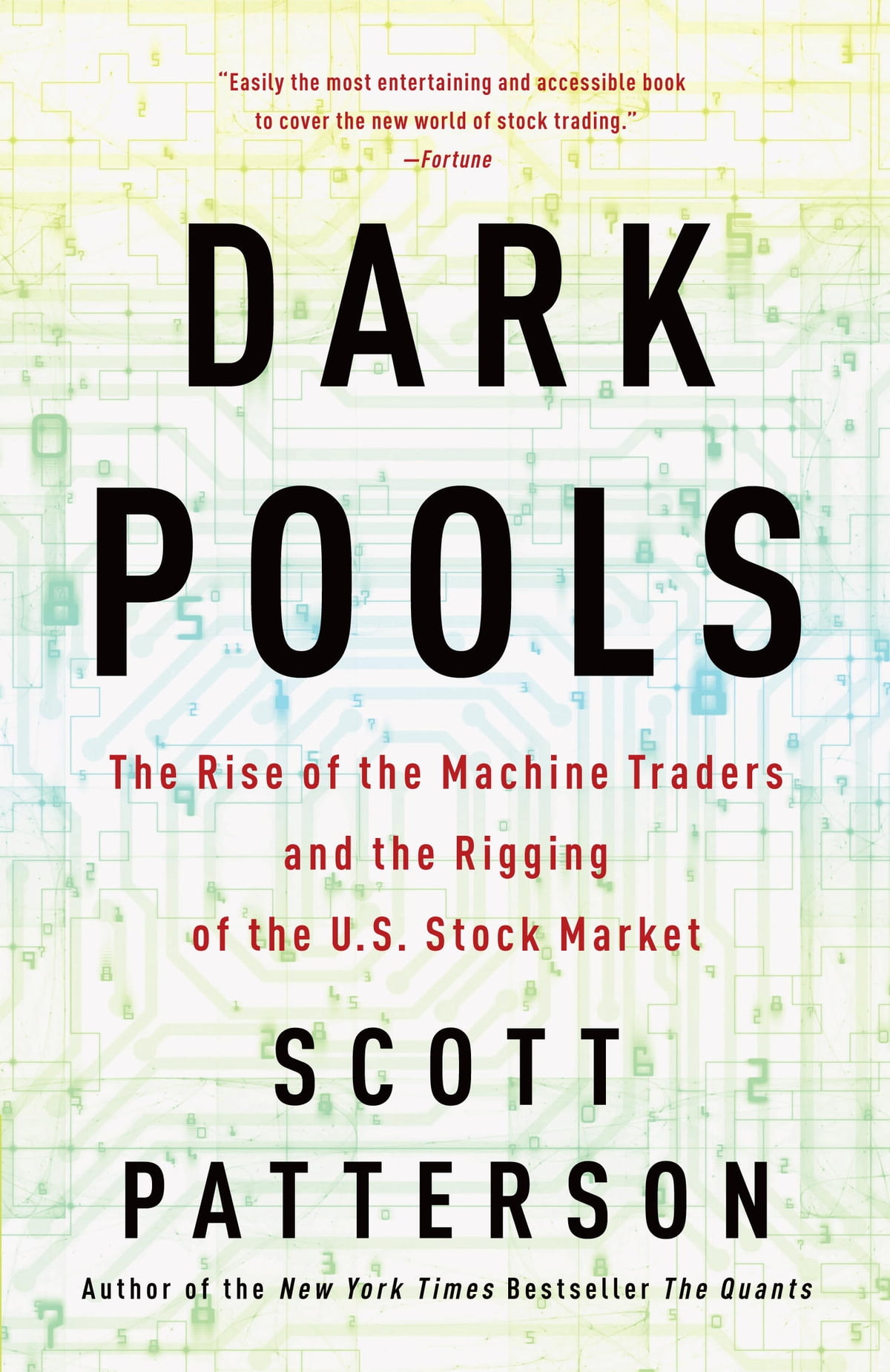Dark Pools

So we got screwed again. But we learned something today and that's all we can do, keep learning, keep trying. It isn't supposed to be easy. See you tomorrow.
★ Rigged trade-orders
In early December 2009, Haim Bodek finally solved the riddle of the stock-trading problem that was killing Trading Machines, the high-frequency firm he'd help launch in 2007. The former Goldman Sachs and UBS trader was attending a party in New York City sponsored by a computer-driven trading venue. He'd been complaining for months to the venue about all the bad trades—the runaway prices, the fees—that were bleeding his firm dry. But he'd gotten little help.
At the bar, he cornered a representative of the firm and pushed for answers. The rep asked Bodek what order types he'd been using to buy and sell stocks. Bodek told him Trading Machines used limit orders.
The rep smirked and took a sip of his drink. "You can't use those," he told Bodek.
"Why not?"
"You have to use other orders. Those limit orders are going to get run over."
"But that's what everyone uses,” Bodek said, incredulous. "That's what Schwab uses."
"I know. You shouldn't."
As the rep started to explain undocumented features about how limit orders were treated inside the venue's matching engine, Bodek started to scribble an order on a napkin, detailing how it worked. "You're fucked in that case?" he said, shoving the napkin at the guy.
"Yeah."
He scribbled another. "You're fucked in that case?" "Yeah."
"Are you telling me you're fucked in every case?” "Yeah."
"Why are you telling me this?"
"We want you to turn us back on again," the rep replied. "You see, you don't have a bug."
Bodek's jaw dropped. He'd suspected something was going on in- side the market that was killing his trades, that it wasn't a bug, but it had been only a vague suspicion with little proof.
"I'll show you how it works."
The rep told Bodek about the kind of orders he should use— orders that wouldn't get abused like the plain vanilla limit orders; orders that seemed to Bodek specifically designed to abuse the limit orders by exploiting complex loopholes in the market's plumbing. The orders Bodek had been using were child's play, simple declarative sentences sent to exchanges such as "Buy up to $20." These new order types were compound sentences, with multiple clauses, virtually Faulknerian in their rambling complexity.
The end result, however, was simple: Everyday investors and even sophisticated firms like Trading Machines were buying stocks for a slightly higher price than they should, and selling for a slightly lower price and paying billions in "take" fees along the way.
The special order types that gave Bodek the most trouble—the kind the trading-venue rep told him about—allowed high-frequency traders to post orders that remained hidden at a specific price point at the front of the trading queue when the market was moving, while at the same time pushing other traders back. Even as the market ticked up and down, the order wouldn't move. It was locked and hidden. It was dark. This got around the problem of reshuffling and rerouting. The sitting-duck limit orders, meanwhile, lost their priority in the queue when the market shifted, even as the special orders maintained their priority.
Why would the high-speed firms wish to do this? Maker-taker fees that generate billions in revenue for the speed Bots every year. By staying at the front of the queue and hidden as the market shifted, the firm could place orders that, time and again, were paid the fee. Other traders had no way of knowing that the orders were there. Over and over again, their orders stepped on the hidden trades, which acted effectively as an invisible trap that made other firms pay the "take" fee.
It was fiendishly complex. The order types were pinned to a specific price, such as $20.05, and were hidden from the rest of the market until the stock hit that price. As the orders shifted around in the queue, the trap was set and the orders pounced. In ways, the venue had created a dark pool inside the lit pool.
"You're totally screwed unless you do that," the rep at the bar said. Bodek was astonished—and outraged. He'd been complaining for months about the bad executions he'd been getting, and had been told nothing about the hidden properties of the order types until he'd punished the it by reducing the flow he send to it. He was certain they'd known the answer all along. But they couldn't tell everyone—because if everyone started using the abusive order types, no one would use limit orders, the food the new order types fed on.
Bodek felt sick to his stomach. "How can you do that?" he said.
The rep laughed. "If we changed things, the high-frequency traders wouldn't send us their orders," he said.
★ 0+ Scalping Strategy
Haim Bodek thought practically nonstop for days about what the trade-venue representative had told him that night at the New York party. The way that the abusive order types worked made him think back to a document he'd been given by a colleague that summer as he researched what was going wrong at Trading Machines. The document was a detailed blueprint of a high-frequency method that was said to be popular in Chicago's trading circles.
It was called the "0+ Scalping Strategy."
Bodek suspected that there might be a link between the order types and the strategy.
Riffling through his files, he quickly found it. While the document didn't say which firm used the strategy, he'd been told by the colleague who'd given it to him that one of the most successful high-speed firms employed it, or something closely akin to it. Due to the sophistication of the strategy, he'd guessed from the start that it was probably written by a Plumber.
There was another giveaway that it had originated in Chicago, where Bodek had worked for several years at Hull Trading: "scalping." To a trader, scalping didn't mean the same thing it meant to most people—a suspicious-looking guy peddling tickets for a sporting event or rock concert outside a stadium. In trading, scalping was an age-old strategy of buying low and selling high—very quickly. It was a common practice on the floors of futures exchanges that populated the Midwest—the Kansas City Board of Trade or the Chicago Mercantile Exchange. The 0+ Scalping Strategy was apparently a futures-trading technique that had been transformed into a computer program.
Bodek started reading. Page two of the document laid out the purpose of the 0+ strategy. "Simple Goal: use market depth and our order's priority in the Q to create scalping opportunities where the loss on any one trade is limited to '0' (exclusive of commissions)."
He paused at that. Essentially, the author of the strategy was saying that its primary goal was to never lose money—the loss on any trade was "0." In theory, this could be done through a scalping strategy. By being first in the "Q"—shorthand for the queue in which orders are stacked up, like theatergoers waiting in line for their tickets—the firm could always get the best trade at the best time.
But what happened when the firm didn't want to buy or sell? Bodek kept reading.
"GOAL RESTATEMENT: use the market depth and our order's priority in the Q to create scalping opportunities where the probability of a +1 tic gain on any given trade is substantially greater than the probability of a –1 tic loss on any given trade."
Aha, Bodek thought, market depth. That was a reference to the orders behind this firm's orders, the other theatergoers waiting in line. The 0+ trader is assuming that his firm is so fast and so skilled that it can almost always get priority in the trading queue—be the first to buy and the first to sell. The depth behind it, the other orders, is the rest of the market.
The author is saying I always want to win (or rather, I never want to lose). His probability of winning—a +1 tick—is "substantially greater" than a –1 tick loss.
But how?
The rest of the market—suckers like Trading Machines or every- day mutual funds—was insurance. Under the next heading, called SIMPLE PREMISES, the exact meaning of what insurance meant was spelled out.
"If we have sufficient depth behind our order at a given price level, then we are effectively self-insured against losing money. Why? If we get elected on our order, we could immediately exit our risk for a scratch by trading against one of the orders behind us."
In other words, if the 0+ trader buys a stock (gets "elected"), and his algos suddenly detect that the price is likely to fall—they can see a large number of sell orders stacking up in the trading queue—he can flip and sell to the sucker standing behind him, resulting in a "scratch" (no gain and no loss). He can do this because his computer systems can "react fast enough to changing market conditions . . . to 'always' achieve, in the worst-case, a scratch or a cancel of our orders."
It was the Holy Grail of trading. The 0+ trader was describing a strategy that effectively never lost. The rest of the market protected it whenever the firm's algorithms detected the slightest chance that the market was moving against it.
It's brilliant—and diabolical. A firm that has found a strategy that is virtually guaranteed to win on every trade has discovered a hole in the market. Trading is all about taking risk, but this author was describing a virtually riskless trade.
The situation confronting Bodek and other investors not using the 0+ strategy was challenging, to say the least. It was like driving a car down the freeway, and every time you tried to speed up, another, faster car was in front of you. No matter how many tricks you pulled, this car (a 0+ symbol stamped on its hood, of course) was always leading the pack. The only time you could get around it—when it would suddenly hit the brakes and vanish in the crowd behind you—was when a Mack truck was speeding right at you. Worse, the 0+ trader was the Mack truck!
The upshot: Regular investors, the suckers using those stupid limit orders, buy high and sell low—all the time.
The game had changed. Bodek became increasingly convinced that the stock market—the United States stock market—was rigged. Exchanges appeared to be providing mechanisms to favored clients that allowed them to circumvent Reg NMS rules in ways that abused regular investors. It was complicated, a fact that helped hide the abuses, just as giant banks used complex mortgage trades to bilk clients out of billions, in the process triggering a global financial panic in 2008. Bodek wasn't sure if it was an outright conspiracy or simply an ecosystem that had evolved to protect a single type of organism that had become critical to the survival of the pools themselves.
Whatever it was, he thought, it was wrong.
 Nathan Lam
Nathan Lam